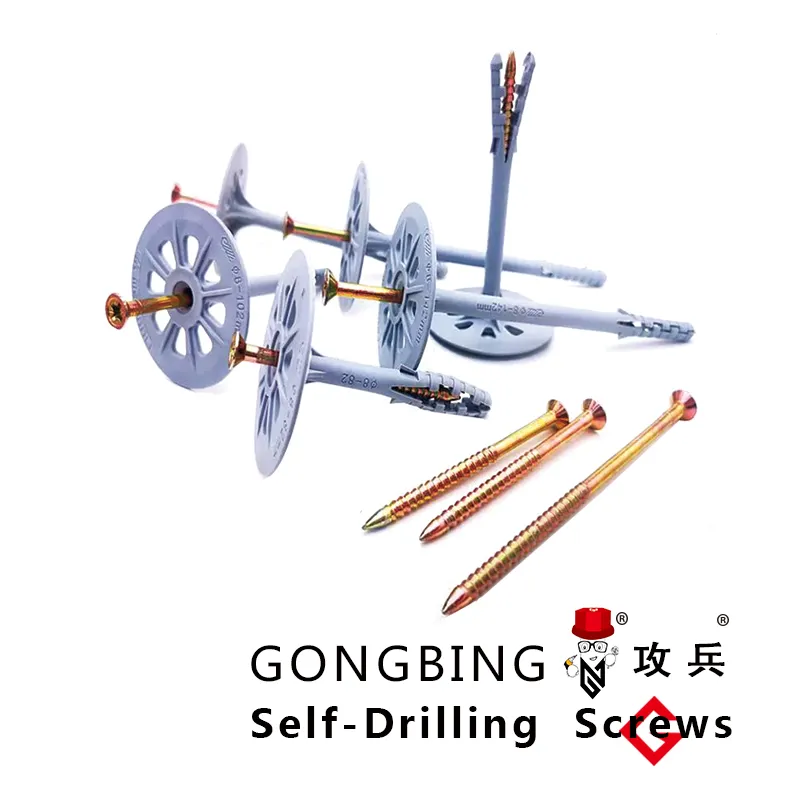Load-Bearing Capacity of External Insulation Fixings
The rise of energy-efficient construction has made external insulation fixings indispensable in modern building design, particularly for multi-story structures. These components, including nails for insulation and insulation nails, must balance thermal performance with mechanical strength to ensure long-term safety and compliance. This article explores the critical role of load-bearing capacity in high-rise projects, the engineering behind durable external insulation fixings, and wholesale strategies for sourcing reliable systems at scale.In high-rise projects, the load-bearing capacity of external insulation fixings is paramount, as they must withstand significant weight and environmental pressures. Engineers meticulously calculate the stress points and forces acting on these fixings to ensure they do not compromise the structural integrity of the building.

Understanding Load-Bearing Requirements in External Insulation Fixings
In multi-story buildings, external insulation fixings bear significant loads from insulation panels, cladding, and environmental forces like wind and seismic activity. Unlike low-rise structures, high-rises experience amplified lateral pressures, requiring fixings to withstand:
Dead loads: Weight of insulation materials and finishes.
Live loads: Wind uplift (up to 1.5 kN/m² in coastal zones).
Cyclic stresses: Temperature fluctuations causing expansion/contraction.
For example, a 20-story building may require insulation nails with a pull-out strength exceeding 2 kN per anchor to prevent detachment. Wholesale suppliers must prioritize standardized testing (e.g., EN 1991-1-4) to ensure compliance across bulk orders, particularly for projects in hurricane-prone or seismic regions.
The Engineering Behind External Insulation Fixings
External insulation fixings are engineered to distribute loads evenly while minimizing thermal bridging. Key design considerations include:
Material selection: Stainless steel or galvanized nails for insulation resist corrosion, critical for humid or coastal environments.
Polymer fixings, often made from nylon or polypropylene, offer good resistance to chemicals and temperature variations, making them suitable for a range of external conditions. The choice of material also affects the installation process, with some materials requiring specific tools or techniques for effective fixation.
Anchor depth: Longer fixings (≥100 mm) improve grip in dense substrates like concrete.
Head design: Wide, low-profile heads reduce stress on insulation boards.
Innovations like helical threads or nylon thermal breaks enhance load distribution. For instance, fixings with dual-thread designs increase pull-out resistance by compared to standard models, a vital feature for multi-story applications. Wholesale buyers should verify that bulk orders meet regional building codes to avoid retrofit costs.
Selecting the Right Nails for Insulation: Strength and Compatibility
Nails for insulation vary by material, coating, and application. Key criteria for multi-story projects include:
Tensile strength: ≥8.8 grade steel for high-load zones.
Substrate compatibility: Concrete, masonry, or steel require different insulation nails.
Fire ratings: Non-combustible fixings (Class A1) for fire-safe assemblies.
For example, self-drilling insulation nails with diamond-coated tips are ideal for hard substrates, reducing installation time in pre-cast concrete façades. Wholesale procurement should emphasize uniformity in sizing and coating to streamline installation across large projects.
Wholesale Strategies for Sourcing Durable Nails For Insulation
For wholesalers, procuring external insulation fixings at scale demands:
Bulk certifications: EN 1990 or ISO 898-1 compliance across batches.
Supplier partnerships: Collaborating with manufacturers for custom lengths/coatings.
Logistics optimization: Palletized, weatherproof packaging to prevent corrosion during storage.
Centralized quality hubs can test random samples from bulk shipments, ensuring consistency. A distributor in Dubai cut returns after implementing batch-tracking for insulation nails, highlighting the value of rigorous oversight.
FAQ: Load-Bearing Capacity of External Insulation Fixings
What factors determine the load-bearing capacity nails for insulation?
Key factors include material grade, anchor depth, substrate type, and installation torque. Stainless steel insulation nails in concrete typically offer higher pull-out strength than those in masonry.
How do external insulation fixings prevent thermal bridging?
Thermally broken external insulation fixings use nylon or polyamide sleeves to reduce heat transfer between the anchor and building envelope, maintaining energy efficiency.
Can the same nails for insulation be used in concrete and steel substrates?
No. Concrete requires mechanical anchors, while steel substrates often need self-drilling insulation nails with specialized drill points to prevent stripping.
What certifications should wholesalers prioritize for external insulation fixings?
Look for fire safety certifications to ensure compliance in multi-story projects.
How does wholesale procurement reduce costs for external insulation fixings?
Bulk orders lower per-unit costs , while standardized external insulation fixings reduce labor training and installation errors, cutting overall project expenses.
In multi-story construction, they are more than fasteners—they are critical to structural resilience and energy efficiency. For wholesalers, investing in rigorously tested, code-compliant systems ensures reliability across projects while maximizing cost savings. As urban construction grows taller and greener, these components will remain foundational to sustainable, safe building practices.
Moreover, they contribute to noise reduction and enhance the overall aesthetic appeal of a structure. By incorporating advanced materials and designs, these systems offer improved durability and resilience against natural disasters. For architects and builders, utilizing such components underscores a commitment to environmental stewardship and occupant well-being, aligning with the global trend towards greener, more sustainable urban development.
-
Weatherproof Plastic Expansion Anchors for OutdoorNewsJun.06,2025
-
Sustainability in the Supply Chain: Eco-Friendly TEK Screws ProductionNewsJun.06,2025
-
Load-Bearing Capacity of External Insulation FixingsNewsJun.06,2025
-
Double Head Bolts: Enhancing Efficiency in Industrial MachineryNewsJun.06,2025
-
Corrosion Resistance in Chipboard Screws: Coatings for Wholesale DurabilityNewsJun.06,2025
-
Butterfly Toggle Bolts : Enhancing Structural ResilienceNewsJun.06,2025
